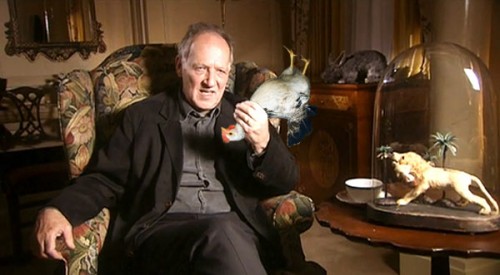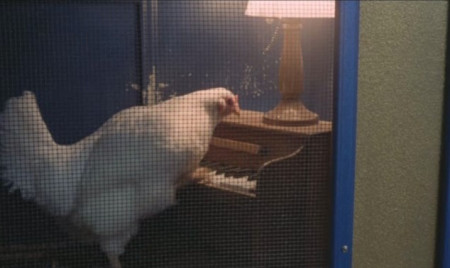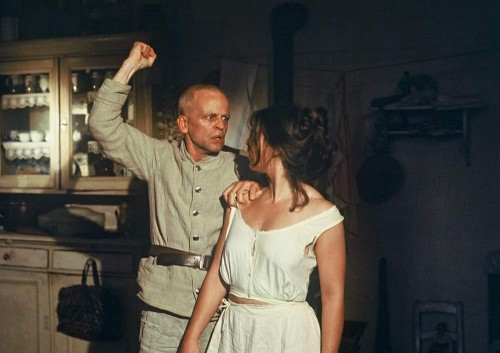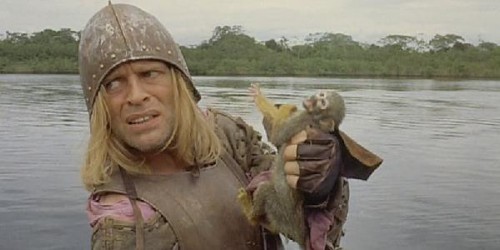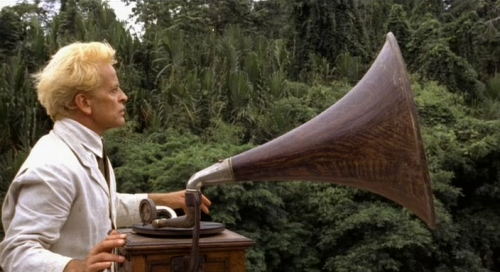THERE EXISTS A list of filmmakers which is constantly in flux—a catalogue of those men and women who’ve gone beyond simply making great movies and risen to the level where their entire oeuvre is worthy of watching. The word “auteur” is thrown around too much, but to get on The List, being one is almost certainly a requirement. The List has some constants: Hitchcock, Kubrick, Godard, Scorsese. It has filmmakers that float on and off it: Spielberg and Woody Allen. It’s not afraid of the artistic, the obscure or the poppy, as long as the films are quality: Wim Wenders and Tarantino are both there; Baz Luhrmann is not. But the specifics of who’s-on and who’s-off don’t particularly matter. This is because The List is my list and is different from your list. And you do have a list, or at least something close to it—whether it’s the “Collected-Stories” list, the “Complete-Discography” list, or the “Every-Film” list, you’ve got one.
And while my forgetfulness and fickleness fortunately keep the list from being static—The List should always change, otherwise going through it is roughly as enjoyable as completing other lists (grocery-, to-do–, hit-)—Werner Herzog has always been on it. He’s a giant of New German Cinema, famous for both his unconventional directorial style and his over-the-top romanticism that seems out of place in the 21st century. In evidence of the former: Herzog refuses to storyboard and relies heavily on improvisation; works in few takes and cares little about continuity errors; frequently casts non-actors from the areas in which he is filming; has hypnotized his cast, threatened to shoot his actors, and dived into a bed of cacti to win their trust. In evidence of the latter, consider Herzog on chickens: “Look into the eyes of a chicken and you will see real stupidity. It is a kind of bottomless stupidity, a fiendish stupidity. They are the most horrifying, cannibalistic and nightmarish creatures in the world.” Eccentric would be an understatement.
So when I heard that the Film Society of Lincoln Center was offering a series of early films by the gun-wielding, fowl-fearing director from Munich, I was understandably excited. I’d seen a fair number of his movies, but only his documentaries which, other than Grizzly Man (2005), are generally less well known than his other films. Until now, the closest I got was borrowing a copy of Aguirre, the Wrath of God (1972) and letting it sit in my laptop for a month before my university library sent me an email telling me that they’d be happy to let me keep the DVD indefinitely if I paid a $400 fee. I opted not to, and never ended up watching the movie. It seemed appropriate to watch Aguirre first at Lincoln Center.
And so I watched Aguirre on Friday. And Heart of Glass (1976) on Saturday. And The Enigma of Kaspar Hauser (1974) on Sunday. Over that week I watched lesser known films—Even Dwarfs Started Small (1970)—and famous ones—Fitzcarraldo (1982). In seven days I’d watched eight Herzog movies and came to an unexpected conclusion: All of Werner Herzog’s early films are the same.
Certainly the specific plots are unique from one another, but structurally and thematically his early work habitually revisits the same elements over and over again. Aspiring filmmakers hoping to create something truly Herzogian, should take note of the following pointers:
- Always open with a wide shot of a remote landscape.
- Voice-over this shot with some general philosophical musings that may or may not actually pertain to the movie. The important thing here is to make sure that whatever the voiceover is, it’s cryptic.
- Casting is important. Remember not to hire anyone who looks too typically “actor-ish,” otherwise you’ll lose indie cred. Also, their acting abilities shouldn’t factor into your casting. The only possible exception to this is the lead—and only sometimes.
- After your opening voiceover, introduce the audience to your characters. One man should have a defining characteristic that raises him above all the other roles. He is smarter or more insightful or morally purer than everyone else. He is the protagonist, and this singular characteristic will drive him to his end, which is more than likely morbid.
- Every other character in the film should generally be an idiot. That’s okay because the viewer won’t be too attached when you kill some-to-many of them.
- Make sure that you have one character who is the creepy-but-silent type. This character has no lines but laughs, hums, sings or whistles in a foreboding way in nearly every scene.
- Any women in the film should have no more than three lines and should only be there to support and/or enable and/or please the male characters.
- All dialogue should be written to suit a fifth-grade vocabulary with the exception of 5-15 “challenge words” that must be included the script.
- Be sure to include at least one symbolism-rich interaction with an animal.
- Figure out the major scenes/plot points of the film. If you have trouble connecting them coherently, just run with whatever you have. Call the film “surrealist,” “experimental,” “avant-garde,” or “new wave” and no one can criticize you.
- The framework of the film is a quest story whose end goal is unattainable. The audience knows things are bound to end in failure. The characters may or may not know. Everybody goes along for the ride anyway.
I say all this tongue in cheek. While Herzog’s films undeniably vary in quality, it’s equally undeniable that he is a fantastic filmmaker. Still, it’s hard to get around the fact that his early work exhibita many of the above characteristics. For example, look at Herzog’s affinity for including animals in his movies. If a director includes interactions with animals in one or two of their films, it’s easy to write it off as coincidence. When a director has animal encounters in all of his films, the repetition becomes something more. Herzog falls definitively into the second group: a deranged conquistador talks to monkeys (Aguirre); a wild boy is cast as a sideshow freak alongside a performing bear (The Enigma of Kaspar Hauser); dwarfs crucify a monkey, murder a pig and laugh at a camel (Even Dwarfs Started Small); a man in pursuit of money feeds a wad of cash to a fish (Fitzcarraldo); a psychic wrestles with an imaginary bear and philosophizes to a Muscovy Duck (Heart of Glass); a donkey is shot to death by an insane soldier (Signs of Life, 1968); chickens dance, ducks play the drums, and rabbits ride a toy fire engine while a depressed musician kills himself (Stroszek, 1978); a monkey dressed as a soldier performs for a laughing crowd while a cuckold, himself a soldier, sits with his wife and her lover (Woyzeck, 1978).
http://www.youtube.com/watch?v=PSDC_LXfBcE
So, what are we to make of all this repetition? First and foremost, it’s important to note that repetition has no bearing on aesthetic value. It can tell us about what’s important to an artist, it can highlight thematic elements in a story, and it can set the tone for a single piece or a whole body of work. It cannot, however, determine whether the art itself is good. Repetition crops up over and over again in different forms and conceptions: The National performing “Sorrow” over 100 times at MoMA, Warhol’s ubiquitous soup cans, Nicholas Sparks writing seventeen versions (no joke) of the same novel about white people in love, Donald Judd’s stack sculptures. And while repletion is deployed by all these artists, they achieve varying levels of success due to their handling of both their medium and repletion itself. Repetition indicates neither an amateur’s ham-handed attempts at creation nor a master’s carefully developed individual style. Like a roll a film, a tube of paint, or a series of words, repetition is just a tool in an artist’s arsenal, and their choice to use it or not has no bearing on the quality of the work.
In fact, when it comes to aesthetics, not only is repetition a-valued, it’s also inevitable. In her novel O Pioneers! (1913), Willa Cather writes that “There are only two or three human stories, and they go on repeating themselves as fiercely as if they had never happened before.” It may be possible to name more than two or three truly human stories, but Cather has a point. Especially when it comes to narrative art, we’ve been telling the same stories generation after generation, trying to put a new spin on it. For Nicholas Sparks, it’s the star-crossed lovers á la Shakespeare’s Romeo and Juliet á la Ovid’s Pyramus and Thisbe. For Herzog, it’s the quest á la Arthur á la Odysseus.
At face value it seems like a bold assertion to claim that Herzog’s stories are all quests. For Aguirre it’s easy: A conquistador leads his mutinous band of explorers down the Amazon in search of El Dorado. Similarly, Fitzcarraldo tells the story of an opera aficionado who dreams of building an opera house in a remote Peruvian village. To raise the money needed to do so, he decides to harvest and sell rubber, hauling a steamboat over a mountain to try and reach untapped acres of rainforest.
But what about his other films? It’s in these that the viewer truly sees how Herzog tries to redefine the quest story: by making the object of the quest the intangible, the mental. From his very first feature, Signs of Life, Herzog’s characters look for freedom, acceptance, normalcy, security. Kaspar Hauser is the story of a man, born in the wild and raised without any real social contact trying to adapt to and understand an unforgiving society who only cares about him for his status as an oddity—a quest for normalcy. In Even Dwarfs Started Small, a group of dwarfs take over the institution in which they are being held in a quest for true freedom and the promises it holds. Woyzeck’s title character is a soldier who wants nothing more than to reestablish the life he had before his wife began cheating on him—a quest for security. The list goes on…
But, if repetition is essential to Herzog’s storytelling, it’s also an essential part of those stories. Herzog’s worlds are built around an individual’s repetitiousness and the effects it has on them and those around them. Much as the aesthetic value of repetition is nonexistent, there are no inherent qualities belonging to characters engaged in repetition. Instead, as one can see by looking at Herzog’s early films, repetition can be understood as a sort of tipping point that can be constructive or destructive in nature—and paradoxically, sometimes both.
Repetition as a constructive force is often renamed dedication, perseverance, or stability: the committed entrepreneur, the starving artist, the comfortable bourgeois. Destructive repetition, on the other hand, is seen as compulsion or mania—or it is rendered even worse when it lacks mania’s passion and manifests itself as the dreaded mundane. While these two ideas of repetition may seem like opposites, they are actually closely related. The difference between the athlete and the mad scientist—the one trying to achieve world domination while constantly taking beatings from his nemeses, the other doing the same only while carrying a football—is a thin line.
It’s no surprise then that most if not all of Herzog’s protagonists, engaged in their own ways with repetitious acts, exist in varying degrees of mental instability. They are each heroes and anti-heroes in their own right.
You don’t have to be a traumatized soldier or a delusional conquistador to understand the effects of repetition on the human psyche. In fact, we’re engaged in our own repetitious worlds every day. Wake up, shower, commute, work, commute, watch that episode of Breaking Bad we DVR’ed, go to sleep, then do it again. Despite the negative connotations so many of us have with this daily routine, we’re still wedded to our repetitious lives in one form or another, whether it be through workaholic mania—I can’t change anything about what I’m doing otherwise I’ll never make partner—or the mundanity of self-preservation—I can’t quit, how would I survive?—just look at the job market! But if we are naturally inclined to have a distaste for this repetitious lifestyle, we are also as naturally inclined to turn a blind eye to the fact that such an existence is entirely our own doing. We perpetuate this repetition for no other reason than to fulfill a social contract that we’ve made unconsciously with ourselves.
The hyper-individual causes of repetition come acutely into focus when you watch too many Herzog films in too short a time. (Or, truthfully, binge watching anything. But hey, you’ve got to catch up on that Breaking Bad somehow, right?) By repeating a new act that is outside the sphere of your normal daily routine, you become aware that even the most dull, monotonous tasks are fully autonomous actions. This isn’t revelatory, but being reminded how much of your day-to-day existence is taken up with repetitions is unsettling. After starting to watch Herzog’s films, I didn’t get off work, cook dinner, sleep, repeat anymore. The routine was still there, but it was fundamentally altered.
I climbed down the uncanny valley of the New Routine, that paradox where everything is both foreign and familiar. I saw the same ticket taker every day. Told them I was on the press list every day. Received the same orange ticked printed with COMP $0.00 every day. Handed it to the same usher at the same door everyday. But neither ticket taker nor usher recognized me. The films changed, as did the audiences. I got used to the walk to the train, the overpriced boutiques I passed along the way, and the route I would take home afterward. The process of watching these films had all the marks of the mindless repetition we go through every day, but still felt deeply new.
It was disorienting—and at the same time liberating. I got to know my seat in the theater—last row, #9. It squeaks if you lean back. I learned to appreciate the mediocre iced coffee I got from the concession between screenings. I grew to tolerate the aggravating film school graduate banter I overheard before each film—“My thesis film had much more authentic costume design.” And yet, despite the monotonous qualities of the situation, I felt happy, empowered. The repetition I was engaging in, I realized for the first time, was totally autonomous. I chose to walk that route to the subway. I chose to go to the screenings. I chose to sit in a broken chair. In the paradoxical nature of repetition I found both newness and normalcy, change and stasis, self-assertion and routine. There was satisfaction in the security of knowing what I would do with my evenings, but I could recognize the danger of growing complacent with doing the same thing over and over. There was a joy in giving into repetitive obsession—I have to watch them all!—and a release in doing so—I’ve watched my movies for the day, I am complete. It was exhausting and repetitive and amazing and boring and surreal all at once. Herzog would approve.
Looking at Herzog’s best-known early work proves useful in illustrating this point. In Aguirre, a group of conquistadors march through the Andean jungle in search of El Dorado, hoping to strike it rich and convert the natives. But when they start running low on supplies, their leader sends a group to scout ahead in hopes of finding food or civilization, noting that they must return in a week, otherwise they will be abandoned in the jungle. The group proceeds downriver on four shoddy rafts, but after a series of unfortunate events where one of the raft’s crew is murdered and the other rafts are swept away, the group’s leader decides the scouting party must turn back. Don Lope de Aguirre, the scouting party’s second-in-command, leads a mutiny, rallying support by enticing the men with promises of fame and fortune once they find the fabled El Dorado. The rest of the film is a slow trip down the Amazon on a single raft where the mutinous crew is slowly killed off by starvation and the attacks by the native population. All the while, Aguirre—unstable from the beginning of the movie—slips deeper and deeper into madness in his quest to reach the mythical city. By the end, he has gone completely insane. Alone on a raft of dead mutineers, surrounded by small monkeys, he declares that he is the “Wrath of God” as he slowly continues down the river.
Repetition is paramount to the success of Aguirre—both man and movie. Shot after shot of the jungle from the raft, ambiguous as to whether or not they are distinct recordings of the rainforest or simply the same cut used multiple times, emphasize the madness that awaits excessive, monotonous repetition. Equally monotonous are the characters’ lives on the raft. They slowly creep down the Amazon, occasionally eating what little food remains, claiming everything they see as part of their new kingdom. Indeed, the only punctuations of this life adrift are repetitions of death, both the not-infrequent attacks by the natives and the increasingly odd deaths of key crew members—the hanging of the overthrown captain, his wife sacrificing herself to cannibals, the only horse on the trip being thrown overboard. In conjunction with Aguirre’s single-minded pursuit of El Dorado, it’s easy to see repetition’s destructive force, especially when deployed for a viceful end as it is in the mutineers’ greed. However, in urging his weary men on, Aguirre frequently invokes the name of Hérnan Cortés, reminding them that great explorers must take great risks and overcome the hardships they face—both mental and physical. And it is indeed true—Cortés and Aguirre share the same motivation and dedication. In the end though, Aguirre reminds us that those who give themselves completely to any cause are not guaranteed success. Far from it. For every Cortez, there are hundreds, if not thousands, of Aguirres.
If Aguirre is a warning about the destructive nature of repetition with a footnote about its possibilities, Fitzcarraldo is just the opposite. An opera lover, Fizcaraldo’s passion for music borders on the insane. He too sets out on a boat (his steam powered) with a crew of locals to find a piece of rainforest and harvest its rubber to raise money to build an opera house. Unbeknownst to the crew, Fitzcarraldo’s plan involves hauling the boat over a mountain, and in the process much of the crew abandons him due to their fear of being attacked by natives. Eventually the natives surround the boat, but, impressed by both his ship and the opera he plays, they believe Fitzcarraldo to be a god, and they carry the ship over the mountain. After a night of celebration, however, their leader cuts the ship loose to appease the rapids that had made the area inaccessible in the first place. The boat and its crew miraculously emerge intact—but empty-handed. Fitzcarraldo sells the steamer to a local rubber baron and takes it for one last journey, returning with an opera company he’s hired using the money from the sale. They pull into port, and the Italian tenor Enrico Caruso belts “A Te O Cara, Amor Talora.”
Fitzcarraldo and Aguirre exhibit many of the same narrative, thematic and cinematic elements: boats, natives, jungles, and singular obsessions for which their titular character will sacrifice much. Still, Fitzcarraldo’s repeated failures are tempered by his one success in bringing music to the jungle. A barge full of musicians may be a far cry from an opera house, but this accomplishment at the end of a long struggle is given poignant meaning, underscored by the opera company’s song choice:
To you, O beloved, my love once
Led me secretly and in tears;
Now it guides me to your side
Amidst joy and exultation.
In the radiance of such a happy time,
When I remember my torment,
My joy is re-doubled,
My emotions are more precious.
It’s hard not to think about repetition in these films when you attend so many in such short a time. Becoming aware of the mindless motions many of us go through in our everyday lives certainly isn’t as great a feat as hauling a boat over a mountain. And watching a series of movies in a comfortable uptown theater isn’t the kind of adventure that would warrant a feature-length film. But spending a week with these movies was a worthwhile use of time nonetheless.
So what should we take away from Herzog’s early films? Are they a warning to avoid greed? A commendation of dedicating your life to art? A reminder to approach water-based travel at our own risk?
In the end, his films are both encouraging and cautionary tales. These are morality stories, contemporary fables encouraging us to chase our dreams but reminding us of the dangers that come with obsession. Undoubtedly important is the historical context in which these films were made—a postwar German filmmaker working during the height of the Cold War begs an historical reading. Acknowledging as much (an leaving the task to another writer), these films stand on firm footing even outside such a context. They warn against extremes, teaching the virtue of moderation. Yet at the same time, they echo D. H. Lawrence who wrote that it is “better [to] die than live mechanically a life that is a repetition of repetitions.” These are legends from which we are supposed to learn, yet are realistic in their outlook, recognizing that not everyone can be a winner, and even when you get what you want, there is an unavoidable opportunity cost. These films have a complex view of repetition, both within art and within our lives, recognizing the power of practice and the danger of mania. No need to worry though: binge watching Herzog—or any director on The List—probably isn’t too bad for you.

